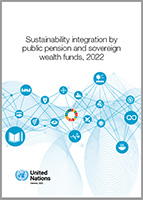
Institutional investors can exert significant influence over their investees and the sustainable investment market through both the size of their holdings and the active nature of their ownership. This study examines ESG and sustainability integration in the investment practices of the world’s 100 largest public pension funds (PPFs) and sovereign wealth funds (SWFs), accounting for $22 trillion in assets under management (AUM).
PPFs and SWFs have long-term obligations and investment horizons. This puts them in a unique position to contribute to the Sustainable Development Goals (SDGs) and take action on sustainability risks, especially climate change. Despite this potential, more than half of the world’s 100 largest public pension and sovereign wealth funds do not disclose or report on sustainability issues, and institutional investors as a group can do more to mainstream sustainability.
Key findings of the report
- Of the 100 funds in the report’s sample, 53 per cent did not report on ESG integration in 2021. Non-reporting funds include 21 SWFs (70 per cent of the SWFs in the sample) and 32 PPFs (43 per cent of the PPFs in the sample).
- However, 47 per cent of the 100 funds did publish meaningful reporting on their sustainability performance and ESG integration strategies (38 PPFs and 9 SWFs). This number is slightly up from 2020, when 40 per cent of funds reported.
- Geographical origin, related to the sustainability regulatory framework, has an impact on ESG reporting and reporting quality: Europe performs better than other regions; SWFs are relatively less transparent than pension funds. The highest-ranking funds are on average almost three times larger than the lowest ranking funds.
- Many reporting funds acknowledge the material risks posed by ESG issues and associated regulatory measures, with a majority of these funds changing their investment strategies and policies accordingly, anticipating transition risks and targeting net zero in their portfolios.
- Reporting funds use at least one of seven sustainable investment strategies to integrate an ESG and SDG perspective into their investment decisions. These range from relatively simple exclusion strategies to more positive screening The SDGs were explicitly referenced by half of reporting funds in their investment strategy.
- Reporting funds are active asset owners, signaling the importance that funds assign to engagement and voting, and the ability of large institutional investors to affect change on ESG and SDG-related issues along the investment value chain. As a general rule, funds favour engagement with asset managers and investees as a first resort to improve ESG performance, and divestment as a last resort if performance does not improve.
- Reporting funds are increasingly sensitive to climate-related risk, with more than four out of five funds having designed a climate or CO2 reduction strategy and the same number reporting the use of an international reporting framework on sustainability, such as TCFD. However, there remains a large variance in reporting with no single, widely accepted.
- Reporting funds are also defining climate related targets for their investment decisions and sustainability integration strategies, with more than two thirds of frontrunner funds using a specific climate target, such as net However, only one in five funds uses an auditing or certification process to evaluate their sustainability reporting and ESG integration.
By reviewing the sustainability reporting of 47 ‘frontrunner’ funds, this study identifies a rich pool of good practices for sustainability integration in six strategic areas: governance, corporate sustainable investment policies, sustainability integration strategies, ESG integration along the investment chain, climate action, and evaluation and reporting.
The findings of the report and best practice cases will also contribute to UNCTAD guidance on sustainability integration for institutional investors, with a particular relevance for developing countries.




